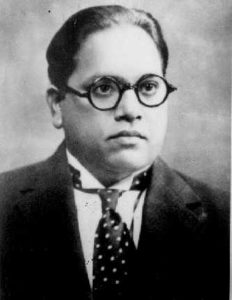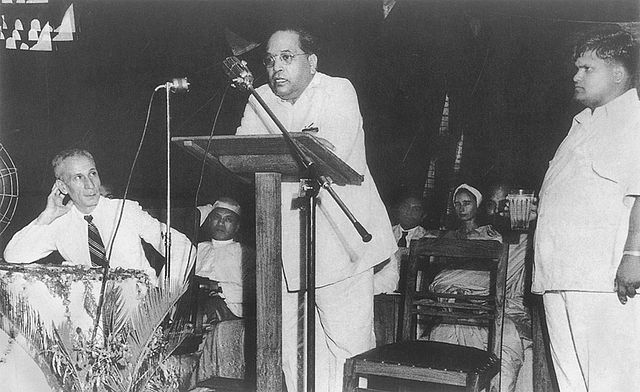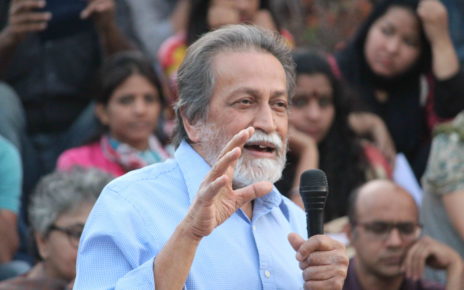(Originally published in People’s Democracy, April 17, 2016)

Everybody is talking about Dr Babasaheb Ambedkar’s life and work today. One of the reasons for this spurt in interest might be the 125th birth anniversary of Ambedkar. However, the interest shown by political parties on Ambedkar today has got other strong political reasons.
Ambedkar’s life work was to a large extent in the pre-independence period. He passed away on December 6, 1956. It was not even a decade since achieving independence at that time. And it was not even five years after the promulgation of constitution, in whose drafting he had played a major part. Though there were attempts by the ruling parties in the last seven decades of independent India to appropriate the legacy of Ambedkar to suit their interests, never were these efforts so intense as we are witnessing them today.
The Congress party is trying to re-embrace Ambedkar with a view to win back the lost support of dalits and other weaker sections. Dalits and other weaker sections who remained for a long time as the solid vote bank for the Congress, started moving away from it in many states after the introduction and pursuance of neo-liberal policies which severely harmed their interests. Now, realising the importance of wearing a pro-poor mask and to regain its lost vote base, it is straining to restore the eminence of Ambedkar in its strategy of wooing the weaker sections.
Sangh Parivar also is showing keen interest in Ambedkar as it considers his ideas and personality a huge hindrance for the realisation of its Hindutva project. To overcome this hindrance, it is trying to appropriate Ambedkar by sanitising and distorting his ideas and transform him into a supporter of Parivar’s revanchist ideology. To realise this, Sangh Parivar is pursuing a two pronged strategy – attack the dalits and browbeat them into submission; and appropriate Ambedkar’s personality by distorting his ideas.
After the assumption of power by BJP at the centre, physical attacks against dalits and other weaker sections have increased manifold. The manner in which the organisers of Ambedkar-Periyar Study Circle in IIT Madras were harassed, the way the central government played a role in the events that led to the suicide of Rohith Vemula of University of Hyderabad, clearly expose their intentions to establish an ‘upper-caste culture’ in the name of ‘Indian culture’. The objectionable words uttered by the president of BJP’s Mahila morcha in Uttar Pradesh demeaning the weaker sections is another recent example. We cannot forget the book written by Arun Shourie sometime back demeaning the personality of Ambedkar.
Sangh Parivar clearly knows that it cannot erase the ideas of Ambedkar by simply attacking him. That is why it is pursuing the second part of its strategy – of appropriating Ambedkar, by distorting his teachings to suit the needs of their Hindutva project. They are campaigning that Ambedkar is a social reformer who had tried to reform and better Hinduism and a great nationalist who rejected Islam and Christianity, by converting to Buddhism, which is a part of Indian culture. They are trying to place Ambedkar in the pantheon of the leaders and ideologues of Sangh Parivar.
However, these attempts by the Sangh Parivar and the BJP lack honesty. The ideas expounded by Ambedkar throughout his life are completely against the ideas of Hindutva forces. He expended his entire life to annihilate the caste system and expose those teachings and ideas of Hinduism that uphold the caste system. Ambedkar had firmly believed that as long as Hinduism exists, caste system and untouchability will exist and so, dalits can be liberated only if they are free from its stranglehold. It is for this reason that only after intense thinking he left Hinduism and joined Buddhism along with his followers. Therefore the efforts by the Sangh Parivar forces to depict Ambedkar as a reformer of Hindu religion are not going to convince anybody especially the oppressed sections.
An entirely different type of process is occurring among those organisations and intellectuals who claim that they are the real inheritors of Ambedkar’s legacy. The failure of slogans like, ‘political power’ to dalits and other weaker sections in achieving substantial progress in the fight against caste system and liberation of dalits, has placed some of them in a dilemma. Faced with this situation, a section of organisations and individuals are losing their hope on the prospects of social change and are happily allowing themselves to be co-opted by the ruling classes. These co-opted sections are trying to create the impression that the advance of few individuals among dalits will lead to the advancement of all. But these illusions are fast disappearing in the face of realities faced by dalits. In effect, capitalist system deliberately promotes some individuals from the weaker sections into the upper rungs of the society in order to ensure the stability of its social system. The slogan, ‘share in power’ is a practical expression of this desire of the capitalist system to promote a few individuals from the weaker sections into the ranks of the ruling class.
Marx noted this long back: “It (capitalist mode of production) constantly drives an unwelcome series of new soldiers of fortune on to the field along side and against the various individual capitalists already present, actually reinforces the rule of capital itself, widens its basis and enables it to recruit ever new forces from the lower strata of society…The more a dominant class is able to absorb the best people from the dominated classes, the more solid and dangerous is its rule”. (Capital, Volume 3, Page 735-736)
Another section of the dalit intellectuals are extremely agitated at the destructive nature of neo-liberal policies. They are noticing the failure and diminishing use of reservations, which were termed as a ‘boon’ given by Ambedkar, realising that they cannot save reservations without fighting neo-liberal policies. They are also agitated at the attempts by the Hindutva forces to derail the debate on caste based oppression and inequality from political agenda by pushing forward their revanchist nationalism, revivalist patriotism and moribund feudal culture.
These dalit intellectuals cannot break the existing disappointment in the dalit movement and move forward unless these forces identify specific ideas of Ambedkar which can help them fight against the forces that are trying to impose their hegemony by promoting neo-liberal policies, communalism and cultural reaction.
A section of dalit intellectuals are unable to shake-off their anti-Marxism and are reluctant to associate with the forces and movements struggling for the rights of the exploited. Many of them have not yet realised the entrenched link between the continuing caste inequities and the capitalist system. Unless they do so, they will be helping the ruling classes in their attempts to distort Ambedkar’s legacy to suit their interests and in the continuation of the capitalist system.
All those dalit organisations and intellectuals who repose faith in Ambedkar should think about joining hands with those who are ready to uphold and take forward the legacy of Ambedkar.
Communists are also showing greater interest now, than earlier, in the legacy of Ambedkar. Unlike the BJP and the Congress, Communists want to preserve and carry forward the radical part of Ambedkar’s legacy in the interest of dalits and other weaker sections. Naturally, this elicited some well-meaning and some mischievous criticisms. Many of the detractors are questioning the sincerity of communists in working for the annihilation of caste system.
Communists never forgot or ignored the objective of annihilation of caste system. It is not an accident that Bhagat Singh had written an essay against caste system in 1928 and also on socialism when in prison. This only goes to prove that whoever thinks about establishing a socialist system in our country, cannot ignore the necessity of annihilation of caste system. It will not be an exaggeration to state that apart from Phule and Ambedkar, there is no organisation other than the Communist party, which was in the forefront in the fight against caste system and its oppressive forms. The political lives of most of the communists started with the fight against caste system. Elimination of caste discrimination was an important component in all the rural peasant struggles led by them. The weakness of communists is not in identifying or fighting caste discrimination. It lies in the failure to understand the dialectical relationship between the struggles for annihilation of caste and abolition of classes and in the uni-dimensional thinking that abolition of classes will automatically lead to the elimination of caste system. This weakness is not confined to the question of caste alone. This applies to the understanding of women’s issue and cultural issues too. Communists realised this long back and hence do not have any inhibition in carrying forward the radical ideas of Ambedkar in fighting caste oppression.
There is no doubt that without destroying the capitalist system, we cannot destroy the caste system at present. But in order to build the class unity required for destroying the capitalist system it is necessary to recognise the hurdles imposed by the caste system.
Although Ambedkar’s basic ideology and communist ideology are completely opposite poles, Communists have never failed to acknowledge the glorious efforts of Ambedkar in fighting caste system and for the welfare of dalits and other weaker sections. Communists intend to move forward by taking all the good in Ambedkar’s legacy, identifying and developing those ideas that are useful for social change and leaving out those ideas and actions that do not suit the present times.
The ruling classes in our country are trying to convert Ambedkar into an innocuous symbol to suit their class rule. His statue has become an important part in this scheme. All Ambedkar’s statues, without any variation, are sculpted with a copy of the Constitution in his hand, as if to show that he had done nothing substantial in his life, except for drafting the Constitution. There is no doubt about Ambedkar’s role in the drafting of our Constitution and it isn’t an exaggeration to praise him as the architect of our Constitution. Apart from Ambedkar’s huge role in ensuring reservations for the weaker sections, we can clearly see his stamp in drafting a liberal and democratic Constitution. In spite of all these, we should not forget that the basic character of our Constitution is safeguarding private property. All those aspects concerning common people are relegated to directive principles, instead of making them fundamental rights. Anybody can understand what kind of Constitution would have emerged if Ambedkar was given complete freedom in its drafting from the memorandum he had submitted to the Constituent Assembly.
Ambedkar had spent only two to three years in his entire life for the preparatory work of the Constitution. All most all of his life had been spent in fighting against caste system and for the liberation of weaker sections. To hide this basic feature of Ambedkar’s life and contribution and push into the background his thoughts for the elimination of caste system, projecting him only as an architect of our Constitution, is a grave injustice to his legacy.
Though Ambedkar’s life has had many facets, his struggle against elimination of caste system and liberation of dalits occupy the pride of a place among them. Ambedkar was studying and writing about caste system throughout his life. Some of the insights provided by Ambedkar about the functioning of caste system will enable those who want to change the society achieve a better grasp of the inner dynamics of the caste system.
His rhetorical statement that caste system is not only a division of labour, but is also a division of labourers points out the necessity of fighting against caste prejudices present in the exploited classes to build real unity of those sections. Another important insight provided by Ambedkar is about the peculiarity of inequality found in caste system which prevents the general development of anti-caste consciousness. He defined it as graded inequality, which means that every caste detests the superiority of the caste above it, but asserts its superiority over the castes below it. Even the sub-castes among dalits are not free from these graded inequalities. Ambedkar has repeatedly emphasised that unless we fight against this ubiquitous graded inequality, it will be impossible to break the caste system and build class unity or strengthen our democratic system.
Ambedkar also highlighted the role of the Indian village in the survival and strengthening of the caste system. He felt that dalits can be freed from caste inequalities only if they are removed away from those who are perpetuating untouchability. That is why he demanded separate villages for dalits. There is a grain of truth in Ambedkar’s perception of village as the bastion of caste system. The strength of the caste system does not lie in the proximity of different castes in the village, but in the concentration of land in the hands of upper and dominant castes. The dependence of lower castes on that land for their living gives them the power to perpetuate caste system. If the monopoly of land in the hands of dominant castes is broken, the power base of the caste system in the village can be broken, which paves the way for fighting for the elimination of the caste oppression.
Ambedkar also stressed the role of education in overcoming caste oppression. He identified the denial of education to shudras, women and untouchables as an important element in perpetuating the caste system. He considered the development of education among the oppressed sections as an important weapon to escape from the village and caste inequalities and to generate consciousness among the oppressed sections to fight back the oppression. That is why Ambedkar worked lifelong for the educational development of the weaker sections.
The need of the hour is to highlight and safeguard those facets in Ambedkar’s personality and thinking that help in ensuring a social change. The radical part of Ambedkar’s legacy which will strengthen the forces fighting for radical social transformation should be safeguarded and emulated. Ambedkar’s life and work cannot be ignored by anybody in our country who is concerned about changing the society.

